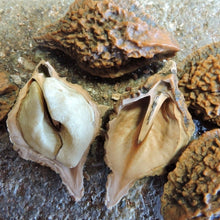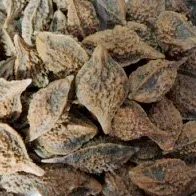|
Mature height x width: |
approx 35'-55' x 50-70' |
|
Recommended initial spacing: |
5'-10' in rows 20' apart |
|
Recommended final spacing: |
40' (intermediate) 60-80' (final) |
| Hardy to: | approx -25°C (-10-15 F) |
|
Preferred soil: |
deep, moist, fertile, well-drained soil |
|
Good for: |
long storage, ornamental, fast-growing, superior flavour |
|
Uses: |
dessert, main dish |
Buartnuts are fascinating trees. They are hybrids of heartnuts (Juglans ailantifolia) and butternuts (Julglans cinerea). This is a nut for lovers of variation, experimentation, and novelty. If you're looking for a well-known tree with dependable yields and predictable qualities, this is not the tree for you. But if you're interested in breeding new varieties of hardy, vigorous nuts on the experimental end of the nutty spectrum, this may be the tree for you. The large hybrid gene pool means that seedlings will express a wide variety of attributes across the two species, including strangely-shaped nuts! Nuts will vary widely in their size, shape, and crackability. Trees will also vary in size, but plan for a very vigorous (fast-growing) tree that reaches 40' at maturity. They may be partially self-fertile, but we recommend at least two trees to ensure the best crop.
Genetics: This is a seedling from a buartnut at Gellatly nut farm in Kelowna, BC. Gellatly was a famous breeder of nuts, and buartnuts are famous for their novelty and vigour.
Planting: we recommend the same thing as heartnuts: deep, moist, fertile, well-drained soil with pH 5 to 8. They do well on north- and east-facing slopes, and they like to be protected from high wind and frost. They will do best in full sun (at least six hours) but can tolerate partial shade (expect slower growth and reduction in yield). Avoid excessively gravelly or sandy soils (chestnuts or pine nuts would be better suited). Walnuts need ample moisture but they won’t tolerate long periods of standing water.
Why seedlings? Growing seedlings from productive, vigorous parents helps maintain diversity (each seed is a new variety) while drawing on some of the best genetics for chestnuts in our bioregion. In other words, by planting seedlings, you are participating in the breeding and selection of new, regionally-adapted varieties! We’ve selected excellent parent stock, but we recommend planting several of these trees closer together and selecting your final tree once they've produced their first nuts (4-8 years).
Why bare root? "Bare root" means that the tree has been grown in the ground (rather than in a pot). In general, bare root trees tend to have larger root systems because their roots aren't constricted by the edges of the pot. Because we don't need to use pots or potting soil, we can sell them more cheaply than potted trees. Bareroot trees must be planted when they are still dormant (Nov - Mar in our region).



